By Esha Chaudhuri
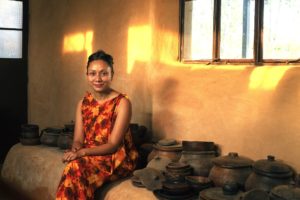
In her most recent exhibit, Rida Gatphoh through her works at Dakti Creations was showcased at the India Art Fair, 2023. A gala art affair with some of the country’s most celebrated artists who highlight thought provoking and visually entrenching artworks. Harbouring the same from our land, Meghalaya, Gatphoh shares her artistic charisma drawing attention to issues of traditionalism along with environmentally sustainable ways of being with Sunday Shillong in a detailed tête-à-tête. Excerpts of the interview are as follows –
-
Congratulations for your most recent exhibition at the India Art Fair. What are your afterthoughts?
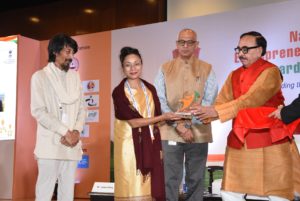 I’m thankful for the opportunity to have been able to address my thoughts on why it is important to create a climate sensitive future in the arts ecosystem. It also makes me happy to see and connect with artists and creators who also focus on ecology and the environment, and raise awareness for a better, more sustainable and more informed art viewing audience. Since we at Dakti Craft curate events and spaces to promote Local voices and Green choices, it was the ideal platform to discuss how and what we can do better in that regard of our exhibitions, fairs, festivals, galleries, biennales, et al, and ensure more carbon offsetting. Perhaps, we will at some point see the change, as more sustainable approaches continue to appear. I am afraid that sometimes the intention behind art fairs is not art but capital, and one doesn’t care much about environmental concerns.
I’m thankful for the opportunity to have been able to address my thoughts on why it is important to create a climate sensitive future in the arts ecosystem. It also makes me happy to see and connect with artists and creators who also focus on ecology and the environment, and raise awareness for a better, more sustainable and more informed art viewing audience. Since we at Dakti Craft curate events and spaces to promote Local voices and Green choices, it was the ideal platform to discuss how and what we can do better in that regard of our exhibitions, fairs, festivals, galleries, biennales, et al, and ensure more carbon offsetting. Perhaps, we will at some point see the change, as more sustainable approaches continue to appear. I am afraid that sometimes the intention behind art fairs is not art but capital, and one doesn’t care much about environmental concerns.2. How did this collaboration come about?
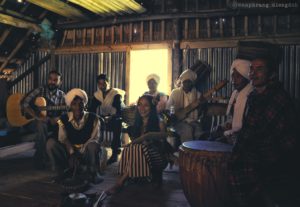 I was invited by one of the curators, Shaleen Wadhwana, who is developing ‘Align and Disrupt’, a program of talks that aims to align voices on critical subjects within the arts ecosystem. Bringing together other artists with similar perspectives that disrupt existing practices and theory to arrive at a sensitive and comprehensive approach for the present and future. While this is a panel to map the efforts and gaps with regard to where we are currently, it is also a blueprint attempt to move towards a more climate-sensitive future through the existing Arts ecosystem.
I was invited by one of the curators, Shaleen Wadhwana, who is developing ‘Align and Disrupt’, a program of talks that aims to align voices on critical subjects within the arts ecosystem. Bringing together other artists with similar perspectives that disrupt existing practices and theory to arrive at a sensitive and comprehensive approach for the present and future. While this is a panel to map the efforts and gaps with regard to where we are currently, it is also a blueprint attempt to move towards a more climate-sensitive future through the existing Arts ecosystem.3. Dakti Crafts was showcased under the theme – ‘What are we causing: Art, Environment & Sustainability’. Please tell our readers how Dakti fits in here?
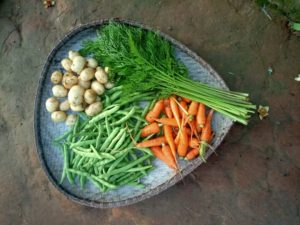 Dak-Ti came about with the key focus to help maintain traditional art forms by involving artisans and creative professionals together in the area of innovation, marketing and sustainability. We believe in creating a sustainable working ecosystem where the gifts of nature and human skill are nurtured in a responsible manner. Uniqueness and concepts of sustainable living have become conscious parameters with consumers globally. In the Dakti philosophy this presents not only an opportunity to create a sustainable economic situation for the arts and crafts sector but will also enable the preservation of traditional activities that are slowly dying out. While elevating a much-needed attention in an industry of intangible cultural heritage and the artisans that hold our traditions – we are also creating a socially conscious practice.
Dak-Ti came about with the key focus to help maintain traditional art forms by involving artisans and creative professionals together in the area of innovation, marketing and sustainability. We believe in creating a sustainable working ecosystem where the gifts of nature and human skill are nurtured in a responsible manner. Uniqueness and concepts of sustainable living have become conscious parameters with consumers globally. In the Dakti philosophy this presents not only an opportunity to create a sustainable economic situation for the arts and crafts sector but will also enable the preservation of traditional activities that are slowly dying out. While elevating a much-needed attention in an industry of intangible cultural heritage and the artisans that hold our traditions – we are also creating a socially conscious practice.4. How did the other presenters (Sharbendu De, Nobina Gupta,Dharmendra Prasad) under the same banner come together?
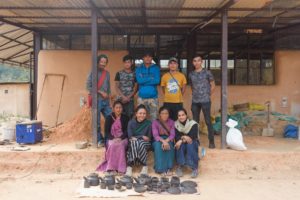 Since the aim of the talk was to align voices on critical subjects within the arts ecosystem, all the four presenters on the panel were those with different perspectives that disrupt existing practices to arrive at a sensitive and comprehensive approach for the present and future through their work and expressions. The panellists were Sharbendu De – a lens-based artist, scholar and writer, Dharmendra Prasad – artist and co-founder of Anga Art Collective, Nobina Gupta – Founder Director of Disappearing Dialogues Collective and myself Rida Gatphoh – founder of Dakti Craft and The Musical Folks.
Since the aim of the talk was to align voices on critical subjects within the arts ecosystem, all the four presenters on the panel were those with different perspectives that disrupt existing practices to arrive at a sensitive and comprehensive approach for the present and future through their work and expressions. The panellists were Sharbendu De – a lens-based artist, scholar and writer, Dharmendra Prasad – artist and co-founder of Anga Art Collective, Nobina Gupta – Founder Director of Disappearing Dialogues Collective and myself Rida Gatphoh – founder of Dakti Craft and The Musical Folks.5. Not many know that apart from your crafty showcasing at Dakti, you’re also a music composer and singer. How do you weave in the two? Does one compliment the other?
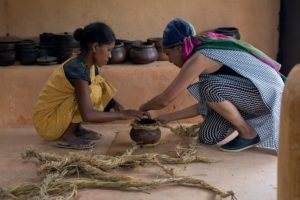 Music is a craft which is a very integral part of Dakti as my journey after I returned to Meghalaya in 2009 started off with the traditional instrument makers in Wahkhen. Traditional music also happens to be a dying art form and so reviving this practice was the first project we took up. In 2013 we started an artist collective ‘The Musical Folks’ and recorded our debut album ‘Musical Nature’ which is an ecological art project in collaboration with folk musicians from across Meghalaya. This project was a small yet intimate exploration that includes an extensive research component such as the cultural and ecological history of Meghalaya, instrument making and nature of the crafts in music. I am extremely honoured to have worked with some of the most respected and gifted musicians on this album at the time when traditional music and instruments hadn’t yet found its place in the modern soundscape.
Music is a craft which is a very integral part of Dakti as my journey after I returned to Meghalaya in 2009 started off with the traditional instrument makers in Wahkhen. Traditional music also happens to be a dying art form and so reviving this practice was the first project we took up. In 2013 we started an artist collective ‘The Musical Folks’ and recorded our debut album ‘Musical Nature’ which is an ecological art project in collaboration with folk musicians from across Meghalaya. This project was a small yet intimate exploration that includes an extensive research component such as the cultural and ecological history of Meghalaya, instrument making and nature of the crafts in music. I am extremely honoured to have worked with some of the most respected and gifted musicians on this album at the time when traditional music and instruments hadn’t yet found its place in the modern soundscape.6. How does your artworks cultivate the idea of sustainability through traditionalism?
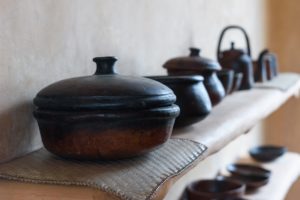 In the natural world we have long looked to the traditional system and practices to adapt and sustain. The goal of safeguarding traditional craftsmanship as with other forms of intangible cultural heritage, is to ensure that the knowledge and skills are passed onto future generations so that the arts and crafts can continue. I use my sustainable craft practice as a reminder of our connection to the environment. Working with crafts made from natural materials or recycled or reused and incorporating traditional knowledge and skill. This requires an intervention between nature and our thinking, reminding us that we, too, are seasonal in our nature. It is a slow and long process, but it is the only valid way forward towards sustainability.
In the natural world we have long looked to the traditional system and practices to adapt and sustain. The goal of safeguarding traditional craftsmanship as with other forms of intangible cultural heritage, is to ensure that the knowledge and skills are passed onto future generations so that the arts and crafts can continue. I use my sustainable craft practice as a reminder of our connection to the environment. Working with crafts made from natural materials or recycled or reused and incorporating traditional knowledge and skill. This requires an intervention between nature and our thinking, reminding us that we, too, are seasonal in our nature. It is a slow and long process, but it is the only valid way forward towards sustainability.7. What are some of the traditional mechanisms of daily living that you incorporate in your creations?
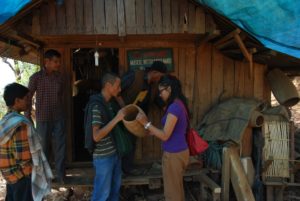 My interest with this practice is more in the long-lasting bonding with the material through preservation and creating value that lies in the way we approach holistically in our daily lives to create balance in our design and thinking. We design products and work with locally sourced materials, avoiding all kinds of toxic and alien substances while considering many aspects of recycling and repurposing, even in our printing, packaging and constructing buildings from sustainable materials.
My interest with this practice is more in the long-lasting bonding with the material through preservation and creating value that lies in the way we approach holistically in our daily lives to create balance in our design and thinking. We design products and work with locally sourced materials, avoiding all kinds of toxic and alien substances while considering many aspects of recycling and repurposing, even in our printing, packaging and constructing buildings from sustainable materials.8. The colours used in your works are largely in monotones. Please tell us more about it.
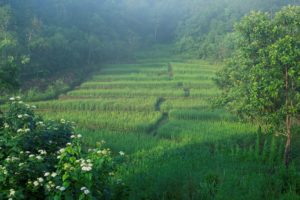 I am now concerned with using materials that have little impact on the earth’s systems. So when it comes to colours, dyes and finishes we only use sustainable resources which are natural or keep the original tone of the material. Have managed to also get a few purple, green, earthy shades from the forest on bamboo. It may not be possible to have a perfect shade but it’s almost like each shade has a story to tell and it satisfies me to know that what we create is truly a product that has not harmed the earth.
I am now concerned with using materials that have little impact on the earth’s systems. So when it comes to colours, dyes and finishes we only use sustainable resources which are natural or keep the original tone of the material. Have managed to also get a few purple, green, earthy shades from the forest on bamboo. It may not be possible to have a perfect shade but it’s almost like each shade has a story to tell and it satisfies me to know that what we create is truly a product that has not harmed the earth.9. Tell us about your studio in Shillong. Where do you source the raw materials and how long did it take for setting it up?
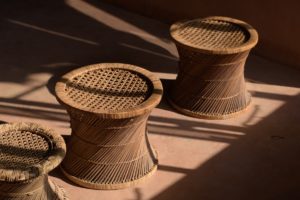 Currently we are setting up our hand-crafted design studio cum workshop in the Ri Bhoi district of Meghalaya, where we conduct much needed training and research and development. We also grow our own food and raw materials on the farm. The studio was hand built using only local and organic materials. It took us quite some time to set up and it will continue to reset itself.
Currently we are setting up our hand-crafted design studio cum workshop in the Ri Bhoi district of Meghalaya, where we conduct much needed training and research and development. We also grow our own food and raw materials on the farm. The studio was hand built using only local and organic materials. It took us quite some time to set up and it will continue to reset itself.10. What does a day in Rida Gatphoh’s life look like?
* like to keep myself engaged in new experiences and learning. It’s always different (smiles)
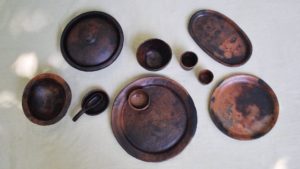 * You have been a recipient of many awards in the past. How do you envision the growth and expansion of such creative works?
* You have been a recipient of many awards in the past. How do you envision the growth and expansion of such creative works?* see my work as a duty to be responsible as well as an instrument and inspiration to make a difference. Our goal is to promote greener solutions towards a sustainable future. We need to connect, collaborate, re-think, re-design and celebrate this journey while being concerned about conservation, protection and climate change.
* As the founder of Dakti Crafts, what is your larger message to readers about traditional crafts and the environment?
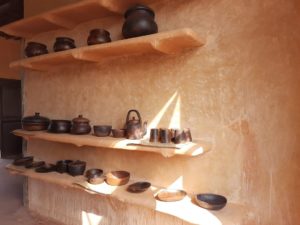 In order to really make a difference we need to value our natural resources and skills while contributing to support local voices and green choices. I would like to quote a few lines from our songs ‘Natural’ from the album ‘Musical Nature’
In order to really make a difference we need to value our natural resources and skills while contributing to support local voices and green choices. I would like to quote a few lines from our songs ‘Natural’ from the album ‘Musical Nature’
Let’s have a meaningful interaction
And reason out with balance
Have natural healing.
Healing for the human non-human
Healing for the soul
The oceans and the sky
The mountains and the valleys
 The flowers and the trees
The flowers and the trees
The birds and the animals
The air that we breathe
The water indeed
We all need healing
We all need healing
– Rida Gatphoh
The design concepts by Gatphoh demonstrates a greener culture of living that inculcates values of environmentally conscious, yet sustainable alternatives. Promoting mannerisms that pave the way for deliberate green choices is the banner that is nestled at Dakti Crafts.



